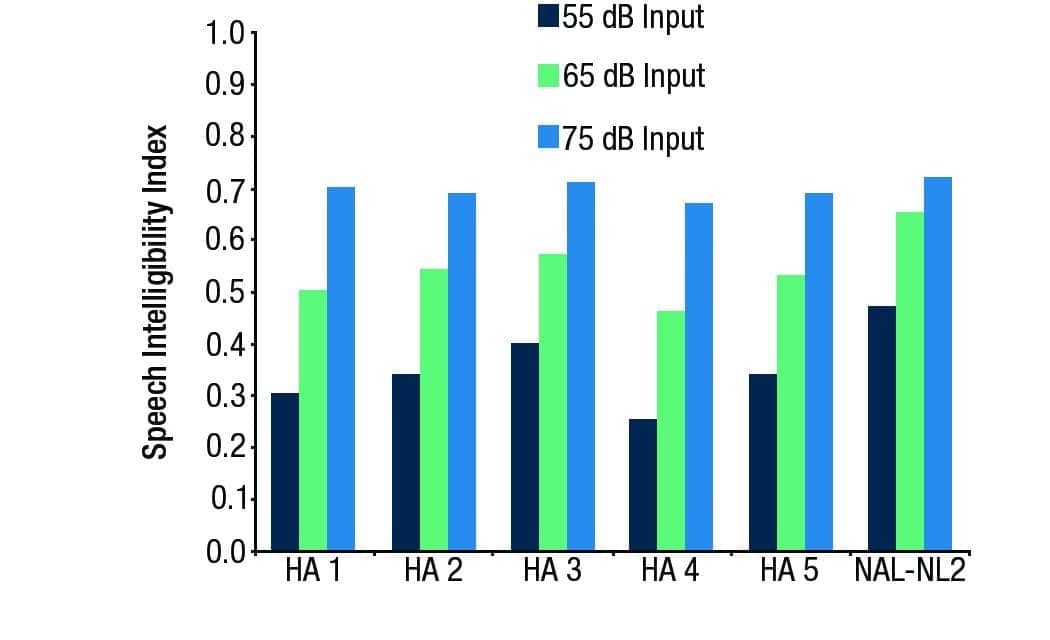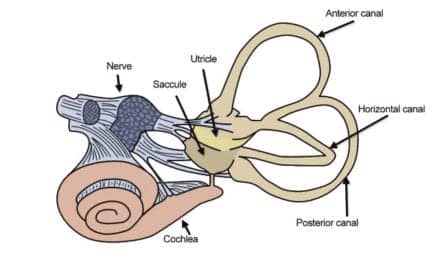Research | March 2015 Hearing Review
One more reason why probe-mic verification is crucial in any Best Practice protocol
This study shows that, if the intended goal of the fitting is to provide the patient with the gain and output of a validated prescriptive method, such as the NAL-NL2, then the dispensing professional cannot rely on the manufacturer’s software version of this algorithm. Real-ear verification is necessary, with considerable subsequent adjustments likely. This, of course, is one of the reasons why probe-microphone measurements are part of all hearing aid Best Practice documents.
New hearing aid technology is introduced each and every year: there are constant updates to directional microphone algorithms, noise reduction strategies, variations of amplitude and frequency compression, wireless streaming, and audio data transfer between hearing aids, just to name a few. What is sometimes forgotten, however, is the basic programming of the hearing aid’s gain and output, which has a significant impact on the patient benefit obtained from these special features. Moreover, while many convenience features have been added to hearing aids in the past few years, understanding speech remains the dominant concern of hearing aid users, and for the most part, this is determined by the frequency-specific gain selected for the patient’s instruments.
At one time, determining the appropriate gain for a given patient was pretty much as simple as taking half of his or her hearing loss for key frequencies. Today, it is a complicated process, as decisions need to be made for multiple channels, sophisticated signal processing, and a wide range of input levels. Fortunately, there are well-researched and validated prescriptive fitting methods available to assist in this process.
While many fitting methods have been introduced over the years, there are currently 2 that are universally accepted: the Desired Sensation Level (DSL) v5.0, and the National Acoustic Laboratories-Non Linear 2 (NAL-NL2).
Prescriptive methods are developed for the average patient, and therefore one might expect some variances in patient performance and preference. But, in general, the findings from researchers who have investigated trainable hearing aids are fairly encouraging: when hearing aid users have had the opportunity to train their hearing aids away from the NAL-NL1 or NAL-NL2 prescriptive gain, on average, after training, their use gain is very similar to these prescriptive methods.1-3 This has been found to be true for both new and experienced users.1 Abrams et al4 reported that, when a verified NAL-NL1 fitting was compared to the manufacturer’s proprietary fitting, significant real-world benefit was present for the NAL-NL1 fitting.
The phrase “fitted to a prescriptive method” assumes verification procedures have ensured that the prescriptive targets have been met using real-ear probe-microphone measures. Unfortunately, there appears to be a disconnect between this fundamental principle and actual clinical practice.
For example, Mueller5 surveyed clinicians and found that 78% of audiologists dispensing hearing aids stated that they routinely used either the NAL or DSL prescriptive method. Yet, only 44% of this same group reported routinely using probe-mic verification. This would lead the reader to assume that many audiologists (and dispensers in general) select a specific fitting algorithm in the manufacturer’s software, but do not conduct testing to verify that these desired gain and output values are present in the real ear.
Similar findings were reported in 2010 by Mueller and Picou.6 Research suggests that this may be a risky practice. Aazh, Moore, and Prasher7 conducted probe-mic verification for 51 fittings for hearing aids programmed to the manufacturer’s NAL-NL1 prescription. They found that only 29% were within ±10 dB of prescriptive target at all key frequencies. When further programming was conducted, however, they found that it was possible to fit 82% of the patients to these prescriptive targets. Further evidence from Mueller8 in 2014 shows that real-ear values for three different manufacturers are significantly different than NAL-NL2 targets when the NAL-NL2 fitting algorithm is selected in the fitting software.
The agreement between the fitting software and the real-ear values would be of little significance if all fittings were verified with probe-mic measures—adjustments simply would be made until an appropriate ear canal output was observed. Mueller and Picou,6 however, reported that their survey showed that only about 40% of dispensers routinely use probe-microphone measures; they went on to suggest that even this low value probably was inflated, based on other survey data they had collected. The prevailing thought is that probe-mic verification probably is only conducted routinely by 25% or so of dispensers (see Mueller8 for review). We’ve already discussed how this relates to the use of validated prescriptive methods, but there is another important link contributing to this breach of Best Practice: the common use of manufacturers’ proprietary fitting methods.
Many, if not most dispensers, when selecting a prescriptive method in the fitting software, choose the manufacturer’s proprietary fitting. This is a gain and output algorithm that has been derived by the manufacturer, presumably believed to be a better starting point than the NAL-NL2 or DSL v5.0, and/or better suited to the specific processing of the manufacturer’s instruments. There are no real-ear targets for these methods, and hence, probe-mic verification is not possible, or at best would be difficult to accomplish. While the use of proprietary fittings is popular, research has shown that this approach will lead to much poorer speech understanding in background noise,9 and significantly less real-world benefit than the use of validated methods verified in the real ear.4
To summarize how hearing aids are being fitted (at least in the United States), it seems that there are 3 general categories:
1) Select a validated prescriptive method in the fitting software, and verify the fitting with probe-mic testing;
2) Select a validated prescriptive method in the fitting software, but do not verify the fitting with probe-mic testing; and
3) Select the manufacturer’s proprietary fitting (not possible to verify with probe-mic measures).
Given that only the first of these three approaches is evidence-based, we questioned how the other two approaches might differ from a validated prescriptive fitting. There has been some previous work in this area, but this has been using hearing aids from only one manufacturer,7 isolated examples,8 or using hearing aids and software that are now outdated.9
In the present study, we conducted real-ear probe-mic testing on a group of participants using the current (October 2014) premier hearing aids and software from the five leading manufacturers. Testing was conducted for both the manufacturers’ proprietary fitting, and using the NAL-NL2 software setting.
Participants and Hearing Aids
Eight adult participants (4 males and 4 females) ranging in age from 21 to 54 were recruited for this study. All participants had clear external auditory canals with no history of middle-ear pathology. The hearing aids used in this research were the premier models available in October 2014 from the following manufacturers: GN ReSound, Oticon, Phonak, Siemens, and Starkey. The hearing aids were all mini-BTE receiver-in-canal (RIC) instruments, coupled to the ear using closed-fitting domes. Prior to probe-mic assessment, quality control testing involving 2cc coupler measures was conducted for all products to assure that they performed according to the manufacturer’s specifications.
Procedures
The current (October 2014) fitting software for each manufacturer was used. Identical downward-sloping sensorineural hearing losses, ranging from 30 dB thresholds in the low frequencies to 75 dB thresholds in the high frequencies, were entered into the NOAH software for each of the 8 participants, for both ears, and subsequently used for programming the hearing aids (one pair from each manufacturer). This hearing loss was selected because it is commonly encountered clinically, and it is severe enough to require amplification throughout the speech range—yet mild enough that target NAL-NL2 outputs could be reached in the high frequencies without feedback issues. For all real-ear testing, only one program was used, and all special features (except for frequency compression) were activated to the default settings. The hearing aids were programmed for a bilateral fitting, experienced user. For all manufacturers, when the NAL-NL2 algorithm was selected, the software fitting screen showed an output that was a nearly perfect match to the displayed NAL-NL2 targets.
Probe-microphone measures were obtained for the 5 sets of hearing aids utilizing the Audioscan Verifit calibrated to ANSI S3.46-1997 requirements. The probe microphone was calibrated prior to testing for each individual. Each participant sat in a chair approximately 2.5 feet directly in front of the Verifit speaker, which was located at a 0° vertical and horizontal azimuth. The probe tube was inserted into the ear canal so that the tip of the tube was within 5mm from the tympanic membrane. Proper placement of the probe tube was verified with otoscopy. The order of testing among manufacturers was counterbalanced across participants.
Real-ear output was assessed using the shaped male talker (“carrot passage”) as the input stimulus. The real-ear aided response (REAR) was recorded for soft (55 dB SPL), average (65 dB SPL), and loud (75 dB SPL) input levels. The resulting aided speech intelligibility index (SII), calculated by the Verifit, was recorded for all hearing aids. The SII values for a precise NAL-NL2 target fitting were also recorded for all inputs. These values were collected prior to experimental testing, as they are not specific to a given real ear.
Two sets of real-ear data were obtained for each pair of hearing aids. For the first set of testing, all the hearing aids were first-fit to the manufacturer’s proprietary fitting formula by following the manufacturer’s recommended procedures. The second set of testing was completed by first-fitting all the hearing aids to the manufacturer’s NAL-NL2 fitting formula, again using the manufacturer’s most current software. No changes to programing were made. For comparison purposes, the fitting targets for NAL-NL2, generated by the equipment for each input level, were recorded. This equipment assumes “experienced user” for these calculations, consistent with the programming of the hearing aids; bilateral fitting also was selected for the Verifit software.
In total, following the real-ear testing, two sets of data from 16 ears were available—ear canal SPL output for each manufacturer’s proprietary first fit algorithm, and data for each manufacturer’s NAL-NL2 fitting algorithm—which then could be compared to the NAL-NL2 targets for the LTASS used by the Verifit system.
Results
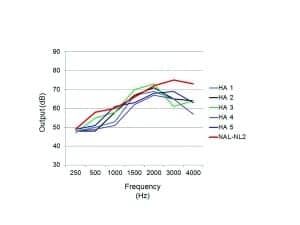
Figure 1a. Results for the manufacturers’ proprietary fittings for male speech passage of Audioscan Verifit; 55 dB SPL input, averaged for 16 ears. NAL-NL2 fitting target shown as reference.
As previously reviewed, Best Practice Guidelines suggest that, when hearing aids are fitted, validated prescriptive methods should be used, verified by probe-mic measures. It appears, however, that many dispensing professionals do not use this recommended strategy, and rather use one of two alternative approaches: 1) program to a manufacturer’s version of a validated method, but do not verify, or 2) program to the manufacturer’s proprietary fitting (with no real-ear verification). The present research was designed to examine the fitting outcomes when these two alternative approaches are used.
Figures 1a-c are the results obtained when the proprietary fitting was selected. These findings are for the inputs of 55, 65, and 75 dB SPL, respectively.

Figure 1b. Results for the manufacturers’ proprietary fittings for male speech passage of Audioscan Verifit; 65 dB SPL input, averaged for 16 ears. NAL-NL2 fitting target shown as reference.
While these algorithms are not intended to match NAL-NL2 targets, we include these values as a reference.

Figure 1c. Results for the manufacturers’ proprietary fittings for male speech passage of Audioscan Verifit; 75 dB SPL input, averaged for 16 ears. NAL-NL2 fitting target shown as reference.
In general, these proprietary fittings are relatively close to the NAL-NL2 for the 65 dB SPL input, but considerably below the NAL-NL2 for the 55 dB SPL input (especially for the high frequencies) and result in output above the NAL-NL2 targets for the 75 dB inputs, particularly for the mid-frequencies.
There appears to be considerable variation among manufacturers, and this varies by frequency. Note, for example, for the 55 dB-SPL input that HA-4 falls about 10 dB below HA-3 in the mid-frequencies with smaller differences for the high frequencies, while HA-3 falls nearly 10 dB below HA-5 at 3000 Hz.
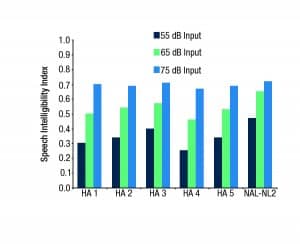
Figure 2. Average speech Intelligibility Index (SII) values shown for three different input levels (55, 65, and 75 dB SPL) for the five proprietary fittings, and the SIIs that would be obtained with a precise fit to the NAL-NL2 prescriptive targets. SII values calculated by Audioscan Verifit using male speech passage input.
Recall that the SII values were calculated for all proprietary fittings, in addition to the NAL-NL2 fitting, and these results are shown in Figure 2. The SII values reflect the same general pattern as can be observed in Figure 1: the differences among manufacturers, and the variance from the NAL-NL2 becomes smaller as the input signal increases. For example, for the 55 dB SPL input, SIIs among manufacturers vary from a low of 0.25 to 0.40, compared to a 0.47 value for the NAL-NL2 fitting. For average inputs, the different products vary from 0.46 to 0.57, compared to 0.65 for the NAL-NL2. For the 75 dB SPL input, the products were fairly similar, and were only 0.1 to 0.5 below the SII of the NAL-NL2.
To examine whether there were significant differences between the proprietary SII values and the NAL-NL2 values, two-tailed independent samples t-tests were performed for each manufacturer. The proprietary SII values across all manufacturers were significantly different (p<0.003, note that Levene’s test was also significant suggesting lack of homogeneity of variance) than the NAL-NL2 values for the 55 dB and 65 dB inputs. Although the values were much more similar for the 75 dB input, all but two of the manufacturers’ proprietary SII values were significantly different (p<0.003) than the NAL-NL2 values.
The primary area of interest in this research was to compare the real-ear output for the manufacturer’s NAL-NL2 algorithm to the NAL-NL2 real-ear targets of the Audioscan Verifit. These data have been plotted as difference curves, with the NAL-NL2 the zero line. Points above the zero line indicate a real-ear output greater than the NAL-NL2; points below the zero line indicate real-ear output less than the NAL-NL2.
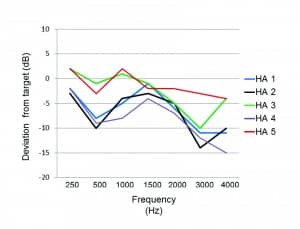
Figure 3a-c. Average difference values for the real-ear output of the manufacturer’s NAL-NL2 algorithm compared to the NAL-NL2 targets of the Audioscan Verifit, derived using the male speech passage input for 55, 65, and 75 dB SPL for panels a-c respectively. The zero line represents the prescribed NAL-NL2 values; points above the zero line indicate a real-ear output greater than the NAL-NL2; points below the zero line indicate real-ear output less than the NAL-NL2.
These findings are shown in Figure 3a-c (inputs of 55, 65, and 75 dB, respectively). As shown, the deviation from NAL-NL2 targets is substantial, especially for the 55-dB input. Note that 4 of the 5 products are 10 dB or more below the desired NAL-NL2 value at 3000 Hz—only HA-5 approximates the NAL-NL2. The match to target is better for the 65-dB input, but the majority of products are still 7-10 dB below the desired levels above 2000 Hz.
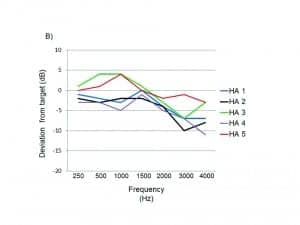
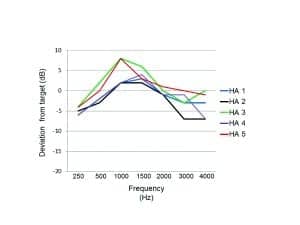
Discussion
The purpose of this research was to compare the proprietary fitting algorithms and the software-generated NAL-NL2 prescriptive fittings for the premier hearing aids of five major manufacturers. Additionally, we examined the fit-to-target for the real-ear output of the NAL-NL2 algorithm, programmed for the same audiogram for 16 ears.
In general, manufacturers’ proprietary fittings have been designed to facilitate “first fit acceptance,” particularly for new hearing aid users. Therefore, it’s probably not surprising that, for all the manufacturers studied, these algorithms provided less audibility than what would be prescribed by a NAL-NL2 fitting, especially for softer inputs.
New hearing aid users are sometimes annoyed by the renewed audibility of soft environmental sounds, so perhaps there is a belief among manufacturers that it is best to limit gain for these inputs.
Of course, this also limits the audibility of speech, which can have a significant impact on speech understanding (see Leavitt and Flexer9). While we didn’t measure speech understanding, if we look at the 55 dB input signal, we would predict that aided SIIs as low as 0.25 (HA-4) and 0.30 (HA-1) would lead to substantially lower speech recognition than the SII of 0.47 provided by an NAL-NL2 fitting. This is certainly a factor to consider when proprietary algorithms are selected.
The NAL-NL2 is a validated algorithm, and is a fitting option provided by most leading manufacturers in addition to their proprietary fitting. We suspect that, when dispensers select “NAL-NL2” in the fitting software, they believe that the resulting ear canal SPL is reasonably close to this prescriptive algorithm.
Unfortunately, for most manufacturers, this is not true. As shown in Figure 3, except for HA-5, the output varies considerably from NAL-NL2 targets. The pattern of deviation from NAL-NL2 seems to be fairly consistent among manufacturers:
1) Reduced gain for soft inputs;
2) Roll-off of high frequencies above 2000 Hz;
3) Boost in gain for mid-frequencies, to the extent that output exceeds NAL-NL2 targets for the 75 dB inputs; and
4) A generally more linear fitting than prescribed by NAL-NL2.
Interestingly, while the real-ear findings of 4 of the 5 manufacturers’ NAL-NL2 algorithms differ significantly from the desired NAL-NL2 targets, they are quite similar to the respective manufacturer’s proprietary fittings.
If we examine the individual fittings, we see results similar to what Aazh et al7 reported for a single manufacturer. Individual data for the 80 fittings (16 ears x 5 products) at the 55 dB SPL input revealed that, in 59 of the 80 cases (74%), the measured output varied from the NAL-NL2 target by 10 dB or more for at least one frequency (250-4000 Hz). If HA-5 (the product that resulted in a reasonably close fitting to NAL-NL2) is removed, of the remaining 64 fittings, 86% varied by 10 dB or more from the desired NAL-NL2 fitting targets. For these later 64 fittings, compliance with the NAL-NL2 was somewhat better for the 65 dB SPL input, but there still were 35 (55%) of the fittings where the ear-canal SPL deviated by 10 dB or more from the desired output.
In summary, these results support the findings from research from past years, indicating that if the intended goal of the fitting is to provide the patient with the gain and output of a validated prescriptive method such as the NAL-NL2, then the dispensing professional cannot rely on the manufacturer’s software version of this algorithm. Real-ear verification is necessary, with considerable subsequent adjustments likely. This, of course, is one of the reasons why probe-microphone measurements are part of all hearing aid Best Practice documents.
References
1. Palmer C. Implementing a gain learning feature. AudiologyOnline, Article 11244 [Aug 2012]. Available at: http://www.audiologyonline.com
2. Keidser G, Alamudi K. Real-life efficacy and reliability of training a hearing aid. Ear Hear. 2013;34(5):619-629. doi: http://dx.doi.org/10.1097/AUD.0b013e31828d269a
3. Mueller HG, Hornsby BWY. Trainable hearing aids: the influence of previous use-gain. AudiologyOnline, Article 12764 [July 2014]. Available at: http://www.audiologyonline.com
4. Abrams HB, Chisolm TH, McManus M, McArdle R. Initial-fit approach versus verified prescription: comparing self-perceived hearing aid benefit. J Am Acad Audiol. 2013;23(10):768-778. doi: http://dx.doi.org/10.3766/jaaa.23.10.3
5. Mueller HG. Probe-mic measures: Hearing aid fitting’s most neglected element. Hear Jour. 2005;57(10): 33-41. doi: 10.1097/01.HJ.0000285782.37749.fc
6. Mueller HG, Picou EM. Survey examines popularity of real-ear probe-microphone measures. Hear Jour. 2010;63(5):27-28. doi: http://dx.doi.org/10.1097/01.HJ.0000373447.52956.25
7. Aazh H, Moore BC, Prasher D. The accuracy of matching target insertion gains with open-fit hearing aids. Am J Audiol. 2012;21(2):175-180. doi: http://dx.doi.org/10.1044/1059-0889(2012/11-0008)
8. Mueller HG. 20Q: Real-ear probe-microphone measures—30 years of progress? AudiologyOnline, Article 12410 [Jan 2014]. Available at: http://www.audiologyonline.com
9. Leavitt RJ, Flexer C. The importance of audibility in successful amplification of hearing loss. Hearing Review. 2012;19(13):20-23. Available at: https://hearingreview.com/2012/12/the-importance-of-audibility-in-successful-amplification-of-hearing-loss/
Correspondence can be addressed to Dr Mueller at: [email protected]
Read more about the importance of verification and validation: The Importance of Audibility in Successful Amplification of Hearing Loss, December 2012 HR; and The Accuracy and Clinical Usefulness of Manufacturer-Predicted REAR Values in Adult Hearing Aid Fittings, Nov 2005 HR.
Citation for this article: Sanders J, Stoody T, Weber J, Mueller HG. Manufacturers’ NAL-NL2 Fittings Fail Real-ear Verification. Hearing Review. 2015;21(3):24.
Jordan Sanders, BS, is a Doctoral Student, Tina M. Stoody, PhD, is an Associate Professor, and Jennifer E. Weber, AuD, is a Professor in the Program of Audiology and Speech-Language Sciences at the University of Northern Colorado, Greeley, Colo. H. Gustav Mueller, PhD, is a Professor in the Department of Hearing and Speech Science at Vanderbilt University, Nashville, Tenn.

